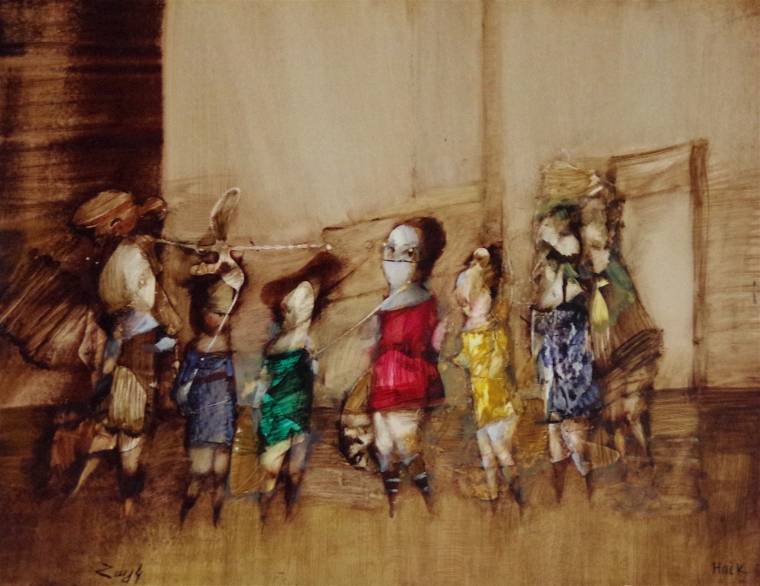How Figurative Oil Painting Transforms Typical Artistic Expression
How Figurative Oil Painting Transforms Typical Artistic Expression
Blog Article
The Role of Emotion and Expression in Metaphorical Oil Painting: An Extensive Analysis of Topic Matter and Make-up
The interplay of emotion and expression in figurative oil painting serves as an important lens via which one can analyze the complex connection in between subject issue and make-up. Artists harness various techniques, from color choice to brushstroke dynamics, to cultivate psychological resonance within their works.
Recognizing Emotion in Art
Emotion in art acts as an effective avenue for expression, allowing musicians to convey complex sensations via their work. In metaphorical oil painting, this psychological depth is commonly depicted via the representation of the human number, recording the nuances of human experience. The choice of topic, color palette, and brushwork all contribute to the emotional vibration of an item.
Artists frequently attract upon personal experiences, societal issues, or universal motifs to evoke sensations in the viewer. A portrait may show vulnerability, while a dynamic number in movement can symbolize freedom or chaos. These psychological threads link the customer to the art work, cultivating a dialogue that transcends the aesthetic medium.
Moreover, the interplay in between light and shadow can magnify psychological intensity, leading the audience's gaze and accentuating particular elements within the make-up. The usage of structure in oil paint additionally adds layers of intricacy, inviting a responsive action that enhances the psychological experience. On the whole, understanding emotion in art is essential for appreciating the subtleties that identify figurative oil painting, as it transforms simple representation into a profound expedition of the human condition.
Secret Components of Structure
In the realm of figurative oil painting, the composition functions as the underlying structure that arranges visual elements and boosts the psychological narrative. Crucial parts of structure consist of equilibrium, contrast, focal point, and rhythm, each adding to the general impact of the artwork.
Balance describes the distribution of aesthetic weight within the paint, which can be achieved through asymmetrical or symmetrical plans. A healthy composition supplies security, enabling the customer to engage with the piece harmoniously - figurative oil painting. Comparison, on the other hand, includes comparing different aspects, such as light and dark or warm and great shades, to lead the visitor's eye and stimulate emotional feedbacks
The focal factor is essential, as it routes interest to the most substantial component of the painting, commonly highlighting the psychological core of the story. By masterfully integrating these key components, musicians can craft engaging and emotionally powerful metaphorical oil paints that captivate and involve their target market.
Topic Matter and Its Influence
Subject plays a pivotal role in figurative oil paint, as it not just acts as the foundation for the story however additionally forms the customer's analysis and psychological involvement with the artwork. The choice of subject-- be it a solitary figure, a team dynamic, or a thematic depiction-- straight influences the psychological atmosphere communicated to the audience.

For instance, pictures often evoke personal connections, revealing the intricacies of human expression and character, while scenes depicting common activities can produce a sense of belonging or fond memories. The cultural and historic context of the subject issue enhances the customer's understanding, motivating much deeper reflections on social norms, worths, and the human condition.
Different topics likewise create differing degrees of involvement; a dramatic dispute depicted via numbers in stress might evoke sensations of anxiety or compassion, while tranquil landscapes can conjure up peace and reflection. Inevitably, the effect of subject in figurative oil paint is extensive, as it acts as an avenue for emotional resonance, directing the audience's reaction and interpretation, and cultivating a link in between the art work and the observer. This interplay is essential for the successful interaction of the musician's intent.
Techniques for Evoking Sensations
The efficiency of figurative oil paint in communicating feelings is considerably influenced by the methods utilized by the artist. Among the most crucial methods is using shade concept, where the strategic option of hues can stimulate certain psychological reactions. Warm colors, such as reds and oranges, find here usually elicit feelings of enthusiasm or aggressiveness, while cooler tones like blues and greens have a tendency to click this stimulate peace or sadness.
An additional necessary strategy is the manipulation of light and darkness, understood as chiaroscuro. This technique boosts the three-dimensionality of figures, creating remarkable contrasts that can magnify emotional deepness. The positioning of light can guide audiences' emotions, highlighting certain aspects of the make-up.
Brushwork likewise plays an important duty; loose, meaningful strokes can communicate power and spontaneity, whereas smoother strategies may suggest peace or accuracy. The plan of subjects within the composition can influence emotional effect. Close proximity can recommend affection, while range may suggest isolation.
Ultimately, the mix of these methods allows artists to craft stories that resonate with the viewer, transforming a plain aesthetic experience right into an evocative psychological trip. - figurative oil painting

Situation Studies of Notable Works
Checking out significant jobs of figurative oil painting discloses exactly how numerous strategies are employed to stimulate powerful emotions. One exemplary case is Edvard Munch's "The Scream," where the altered number and swirling background share existential fear. Munch's use shade-- deep blues and dazzling oranges-- heightens the psychological effect, showcasing exactly how scheme options can shape audience my latest blog post experience.
Another significant work is Pablo Picasso's "Les Demoiselles d'Avignon." Here, fragmented kinds and strong brushstrokes show a tumultuous emotional landscape, challenging conventional depictions of the women number. Picasso's innovative structure not just catches the audience's attention but likewise invites contemplation on motifs of identification and sexuality.
In Addition, Frida Kahlo's "The Two Fridas" provides a poignant expedition of duality and self-identity. The contrasting figures, connected by a common heart, exhibit Kahlo's emotional depth and individual story. figurative oil painting. Her careful focus to detail and symbolic aspects offer to engage viewers on a natural degree
These instance researches emphasize the profound link between feeling and structure in figurative oil paint, disclosing how musicians harness method to communicate intricate feelings and stories that reverberate across time and society.

Final Thought
Finally, the interaction of emotion and expression in metaphorical oil painting significantly improves the customer's experience and interpretation of the art work. Via a mindful selection of subject and compositional strategies, artists convey profound narratives that resonate on both global and personal levels. The application of color concept, brushwork, and chiaroscuro further intensifies psychological deepness, changing each canvas into an effective representation of the intricacies of the human experience.
In metaphorical oil painting, this psychological deepness is typically depicted via the depiction of the human figure, capturing the nuances of human experience.In addition, the interplay in between light and shadow can intensify emotional intensity, directing the viewer's look and attracting interest to particular elements within the make-up. The usage of texture in oil paint additionally adds layers of complexity, inviting a responsive action that improves the psychological experience.The focal point is important, as it guides attention to the most substantial component of the painting, often highlighting the psychological core of the narrative. Eventually, the effect of subject matter in figurative oil painting is extensive, as it serves as a conduit for psychological resonance, assisting the audience's feedback and analysis, and cultivating a connection between the artwork and the observer.
Report this page